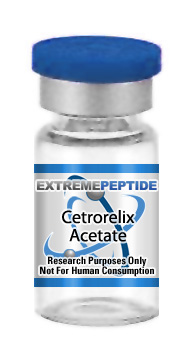(Click here to read our disclaimer)
Ceterorelix acetate refers to a gondatropin releasing hormone antagonist. This is a synthetic decapeptide that is regularly researched for its role in combating hormone sensitive cancers, such as breast or prostate cancers, as well as its roles in some gynecological disorders in women. Cetrorelix acetate may also be researched for its potential in inhibiting surges of luteinizing hormones by blocking the GnRH from the pituitary gland. This peptide is capable of suppressing an animal’s production of FSH and LH for this purpose.
Cetrorelix acetate is commonly applied via injection to animal test subjects in 3mg applications every four days or a .25mg application when it is being administered to test subjects along with regular applications of hCG. These application sizes may vary based on the age, sexual development and species of the test subject in question.
It may be necessary to closely monitor male animal test subjects that are exposed to this chemical as it has been shown to alter the concentrations of High Density Lipoproteins in animals that were regularly exposed to this chemical which may alter the effects and results of a given study.
Systematic Delivery in Anesthetized Rats
Reactions and pulmonary absorption of cetrorelix acetate was followed in rats using a method of non-surgical intratracheal instillation.
Four groups of rats including seven rats each were provided with varying concentrations of cetrorelix along with two control groups containing ten and nine rats respectively.
After the chemical was administered the resistance time was followed using plasma samples which suggested that the chemical was quickly absorbed by the rats’ bodies.
Studies using this method have indicated that intratracheal instillation of cetrorelix acetate using this method can be adopted to provide a non-surgical cannulation that can provide reliable results for researchers. This also helps to indicate that large amounts of active cetrorelix acetate in an animal can be absorbed by the lungs.
Acting as a Potent Antagonist of LH-RH
Hormone suppressing effects and antitumour of lutenising hormone releasing hormone antagonist Cetrorelix was measured using the investigative model that induced DMBA within mammary carcinoma of male and female rats.
Single applications beginning with a high amount of the chemical moving down to maintenance sized applications were applied to each group.
The stability of each molecule that was affected by the degrading enzymes indicated that this poorly soluble pamoate salt was inadequate for facilitating sustained release of active compounds.
These salts did produce a suppression that prolonged testosterone levels and tumor growth. This allowed researchers to conclude that cetroroelix may be a useful LH-RH antagonist that could be developed more fully to address hormone dependent diseases.
Regular and high applications of cetrorelix in animal test subjects have also been found to cause severe renal impairment in some test subjects. This is particularly found in female test subjects which are advanced in age, past the point of a natural menopause.
There is also a very high record of allergic reactions of cetrorelix in a variety of types of animal test subjects, so any animals exposed to this peptide should be monitored with care.
Sources:
http://www.sciencedirect.com/science/article/pii/S0928098799000676
http://www.sciencedirect.com/science/article/pii/0959804996001384
Click here to view our entire PDF research library
Click here to view/download the PDF version of this article
